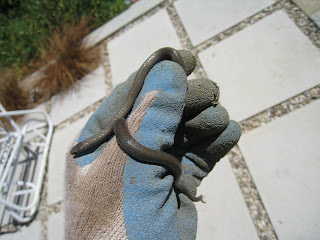There isn't a day that goes by that I don't run across something that makes me think about my Grams. A dirty joke (she could have a pretty raunchy sense of humor). Calla Lilies at Trader Joe's (we would "paint" them with powdered chalk at Easter time). Sweet 'n Low packets at a restaurant (she helped herself to them - for her morning coffee at home). All kinds of random things. Like our vegetable garden - I think often about how much she would have liked it. She would have liked making her chunky mash of our carrots and turnips. Or maybe some sour-creamy borscht from the beets. And then there are the eggplants. No matter what the occasion, my grandma brought two dishes to all of our family gatherings - chopped liver and chopped eggplant. Now, for me, the chopped liver was a no go. But the eggplant? - that was another story.

Gram's Chopped Eggplant (or as close as I can get it)
ingredients
- 1 large eggplant (she always used the common Black Beauty) or about 1 1/2 -2 lbs. other variety
- 1 medium red pepper
- 1 medium tomato
- 1/2 medium white onion
- olive oil
- vinegar
- sugar
- salt and pepper
 |
| post roast |
method
- Pierce each eggplant a couple of times with a fork (they can explode in the oven if you don't!), place them and the pepper on a lined baking sheet. Roast them at 400° until the eggplant begins to collapse and is easily pierced with a fork, 20-40 minutes depending on the size.
- After roasting, place the pepper in a paper bag or tightly covered bowl till cool, 10-15 minutes. Set the eggplant aside until cool enough to handle easily.
- While you wait, dice the onion and tomato. You want the pieces small, but not overly fine. Think salsa. Add to a medium bowl.
- Scoop softened eggplant out of the papery skin into the bowl with the diced veg. Discard skins.
- Peel and seed the pepper. Give the pepper a rough chop and add to the bowl.
- Drizzle in olive oil - start with a good tablespoon. Add a couple teaspoons vinegar - cider, white wine, plain white, whatever you like best. Sprinkle with sugar - start with 1/2 a teaspoon. Add a couple hearty pinches of salt and black pepper.
- Chop the whole mess up. My grandma always used a mezzaluna to chop her eggplant, but use what you have. Two butter knives will do the trick. Stop when you like the consistency. I've seen versions where it is blended. My grandma's was chopped by hand and still chunky.
- Taste and add additional seasonings as you like. Put in an airtight container and let it sit in the fridge for a day or two for the flavors to meld. You might adjust the seasoning again at that point. Serve it cold or at room temperature. Grams always served it with fresh rye and egg breads. It's good on crackers, too.



















































